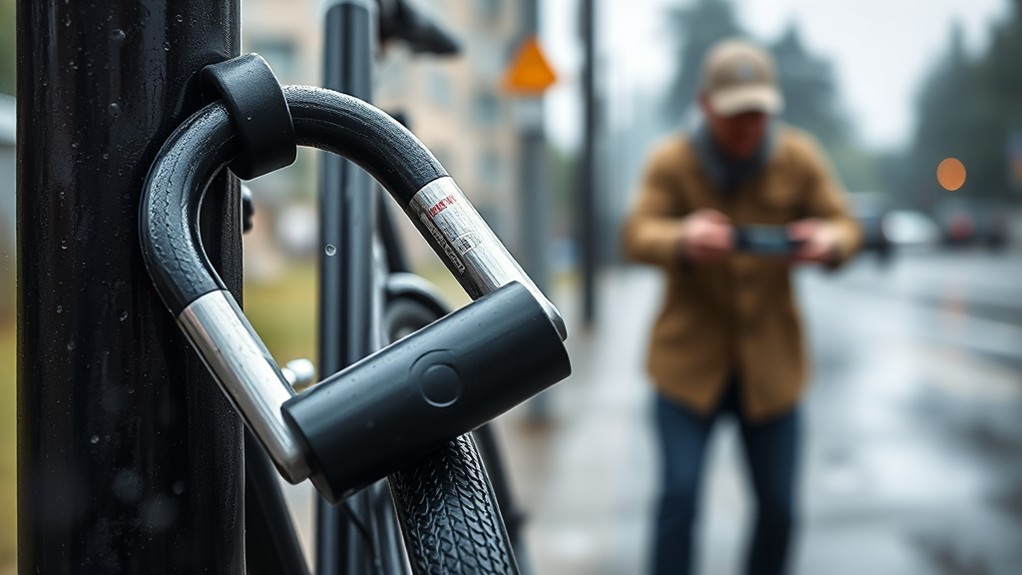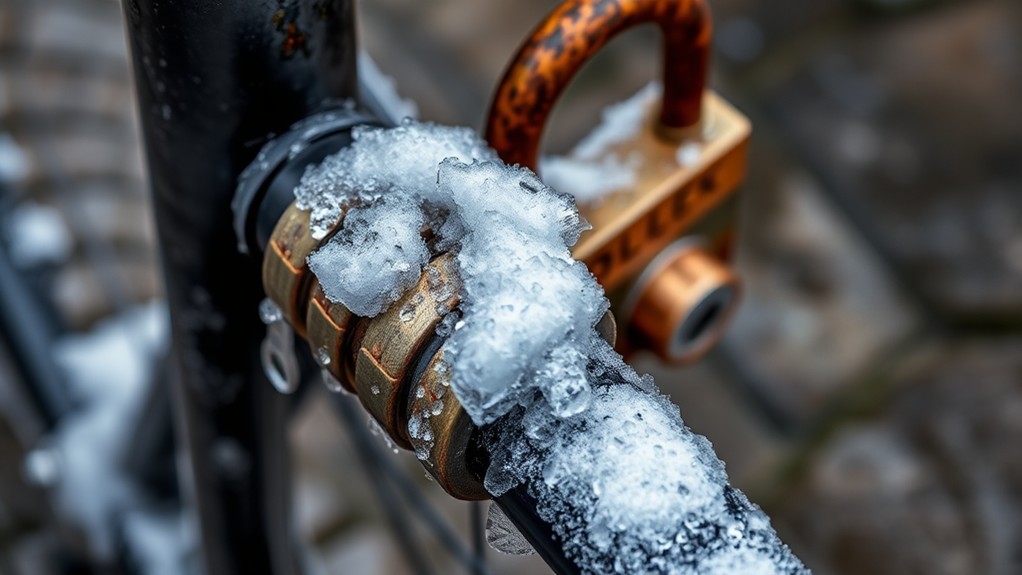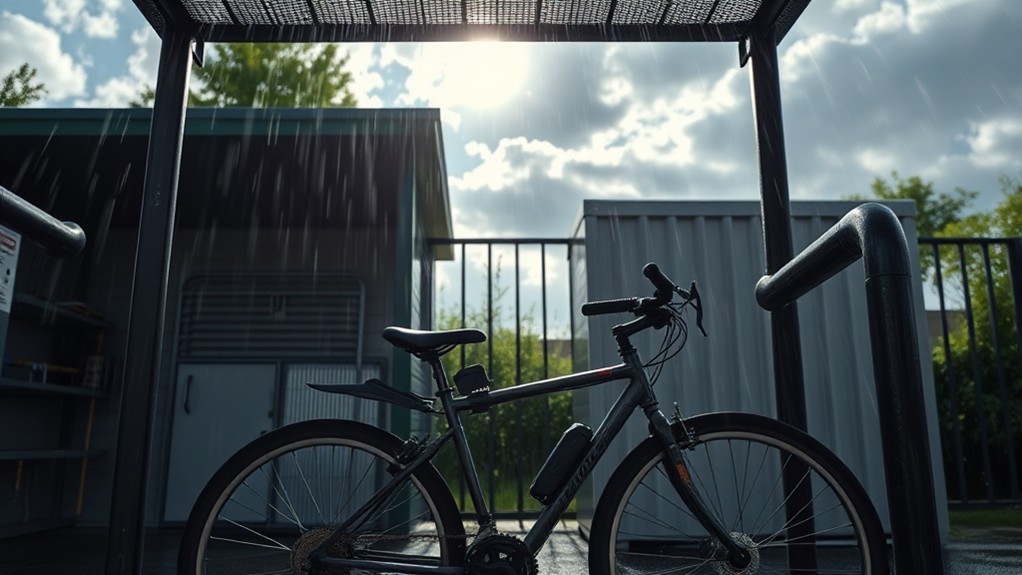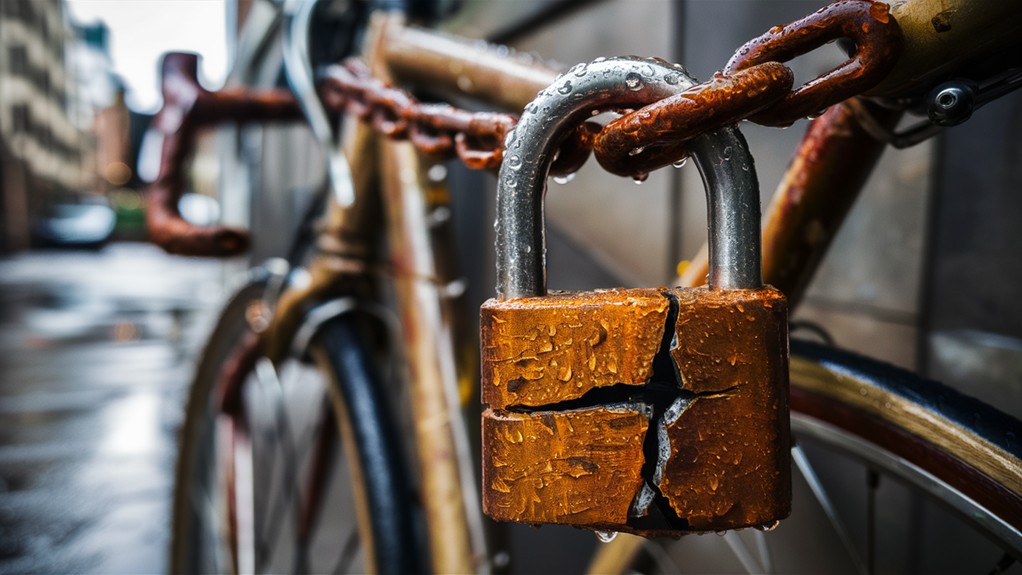Understanding the impact of weather conditions on bike lock security is vital to preventing bike theft and prolonging the lifespan of your locks. Regular maintenance and cleaning procedures, including lubricating keyholes and moving parts every 1-3 months, are fundamental to addressing issues like corrosion and sticking locks. Environmental factors like rain, cold, and humidity likewise affect lock durability, making it vital to choose weather-resistant locks with hardened steel, weather-resistant coatings, and rust-proof components. By implementing best practices for lock usage and selecting high-quality locks, you can protect your bike effectively and minimize theft risks, and exploring the best long-term strategies can help further solidify your bike's security.
Maintenance and Weather Resistance
One essential aspect of ensuring your bike lock remains effective in securing your bike is regular maintenance.
Exposure to weather elements like rain, cold, and humidity can lead to rust and corrosion, negatively impacting lock performance and longevity. To prevent this, take preventative measures such as storing locks in a dry place and avoiding direct exposure to harsh weather conditions.
Seasonal adjustments are additionally important to maintaining your bike lock's functionality.
Here's what you should do:
- Lubricate your lock every three months or with seasonal changes to maintain functionality.
- Use a degreaser spray to remove moisture and prepare locks for lubrication, especially before winter conditions.
- Regularly inspect your lock for signs of wear and take action to address any issues promptly.
Cleaning and Lubrication Procedures
Regularly cleaning and lubricating your bike lock is crucial to maintaining its effectiveness and extending its lifespan. Effective cleaning techniques remove dirt, grime, and corrosion, which can compromise the lock's security. Use WD-40 to remove rust or corrosion, applying it multiple times if needed for effectiveness.
Lubrication Tips
Apply lubricant directly into the keyhole and moving parts of the lock to guarantee even distribution. Operate the lock several times afterward to promote this process.
It's recommended to lubricate every 1-3 months, or more frequently in environments with coastal air or significant temperature changes that can affect lock performance.
When applying lubricant, be sure to:
- Use a lubricant specifically designed for locks
- Apply a small amount to avoid attracting dirt and grime
- Wipe off excess lubricant after application to prevent attracting dirt and grime
- Regularly treat door hinges alongside lock maintenance to guarantee smooth operation and extend the lifespan of both locks and hinges
Best Practices for Lock Usage

In relation to using your bike lock effectively, choosing the right location is key to deterring potential thieves. Selecting busy and well-lit areas greatly reduces theft risk, as visibility is a major theft deterrent.
When locking up, avoid placing your lock on the ground; instead, attach it at a higher point to make it more challenging for thieves to access.
Effective Lock Placement and Use
- Lock both the frame and the rear wheel to a fixed point to secure your bike.
- Consider additional security measures for quick-release components.
- Prevent your lock from making contact with rough surfaces while riding, as this can cause scratches and weaken the lock over time.
Regular maintenance is also crucial. Check and maintain your lock regularly, as consistent upkeep improves its security and functionality against wear.
Choosing Weather-Resistant Locks
When selecting a bike lock, consider the material it's made of, as it can greatly impact its durability in varying weather conditions.
Prioritize materials like hardened steel that resist corrosion from rain and humidity. Look for locks with weather-resistant coatings or seals that prevent water ingress, as moisture can lead to internal rust and malfunction.
Material Selection and Design Features
To guarantee your bike lock can withstand the elements, focus on the following key aspects:
- Opt for locks designed with rust-proof components, such as brass or stainless steel, which are less susceptible to deterioration brought on by exposure to the elements.
- Consider using locks with a rubber or plastic covering to protect the locking mechanism from dirt and grime, which can accumulate because of weather exposure.
- Research locks with a high IP (Ingress Protection) rating, indicating their ability to withstand dust and moisture, enhancing their longevity and reliability in adverse weather conditions.
Lock Durability and Performance

By choosing a weather-resistant lock, you've already taken a significant step in protecting your bike from the elements. However, lock durability and performance can still be affected by environmental factors.
Locks exposed to rain, cold, and humidity are more susceptible to corrosion and rust, impacting their durability and performance. The accumulation of dirt and grime can hinder internal mechanisms, leading to difficulties in operation and potential failure.
Factors Impacting Lock Durability and Performance
Regular maintenance, including cleaning and lubrication, can extend the lifespan of locks by preventing wear and guaranteeing smooth functionality.
Environmental factors, such as coastal air or temperature fluctuations, can necessitate more frequent maintenance to uphold lock performance. Consider the lock materials and their potential environmental impact when selecting a lock.
Signs of wear, such as difficulty turning the key, indicate that the lock may be compromised and require immediate attention to prevent further damage.
Common Lock Problems and Solutions
Common lock problems can compromise the security of your bike, leaving it vulnerable to theft. Different lock types, including U-locks, chain locks, and cable locks, can experience issues because of environmental factors, wear and tear, or key issues.
Regular maintenance is crucial to prevent these problems and extend the lifespan of locking mechanisms.
Some common lock problems and their solutions include:
- Lack of lubrication leading to sticking locks – Regularly apply lubricant to moving parts to guarantee smooth operation.
- Misalignment of the lock or key causing jamming – Inspect both the lock and key for signs of wear or damage and realign as necessary.
- Corrosion and rust because of exposure to humidity and rain – Clean and dry the lock regularly to prevent damage.
- Worn-out keys causing difficulty operating the lock – Test a spare key to determine if the issue lies with the original key and consider replacing it if necessary.
External Storage and Security

You've taken steps to maintain and troubleshoot your bike lock, but even a well-maintained lock can be compromised if the bike is stored in an insecure location.
Regarding external storage and security, it's vital to evaluate the impact of outdoor visibility on theft deterrence. High visibility of outdoor-stored bikes can increase their attractiveness to thieves, making it important to use sturdy locking mechanisms and secure storage solutions.
To minimize the risk, evaluate the following:
- Use two gold-standard locks: one securing the front wheel and frame, and another for the rear wheel and frame.
- Utilize a dedicated bicycle cover to protect your bike from harsh weather conditions, reducing the likelihood of rust and mechanical failures in locks.
Additionally, removing accessories like lights and computers when not in use can prevent theft, as these items can attract potential thieves to bikes stored outside.
Home Storage and Insurance Policies
In relation to home storage, a garage is often the safest place to keep your bike. To guarantee insurance compliance, verify that your policy allows storage in a garage or shed. Integrated garages are generally viewed as safer by insurance companies, potentially leading to more favorable coverage conditions.
Conversely, storing bikes in sheds or detached garages may invalidate insurance claims.
To align with insurance requirements and reduce risk, always lock your bike, even in a garage. Understanding specific insurance policies guarantees that homeowners are adequately protected against theft while storing bikes indoors. Proper bike documentation is likewise crucial for insurance purposes.
When storing your bike at home, consider the following:
- Document your bike storage methods with photos to serve as proof of security for insurance purposes.
- Keep your bike locked to an immovable object, such as a wall anchor or a sturdy bike rack.
- Store your bike in a well-lit, easily accessible area to deter potential thieves.
- Verify that your insurance policy covers your bike against theft, even when stored indoors.
Frequently Asked Questions
How to Prevent Bike Lock From Freezing?
To prevent your bike lock from freezing, you're applying lubricant to create a moisture barrier. Store it indoors during cold weather, and consider a weather-resistant lock to minimize moisture exposure and freezing issues.
What Are the Security Grades for Bike Locks?
When choosing a bike lock, you'll find security grades like Bronze, Silver, Gold, and Diamond, which assess the lock's material strength and theft prevention capabilities, helping you pick the right one for your needs.
What Is the Modified Sheldon Brown Technique?
You're securing your bike with the Modified Sheldon Brown Technique, using two locks of different types to outsmart thieves. This method combines a U-lock and a chain lock, requiring different tools to break both, making it harder to steal your bike.
What Is the Strongest Type of Bike Lock?
You'll find U-locks offer the best protection, with their hardened steel resisting cutting and prying attempts, while high-quality chain locks provide strong durability, but may be heavier, limiting portability compared to U-locks.
